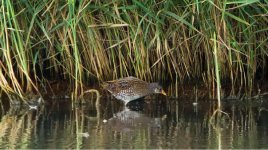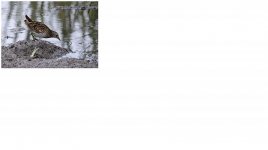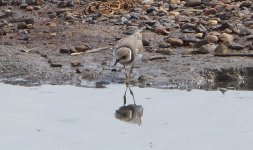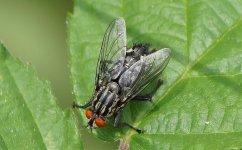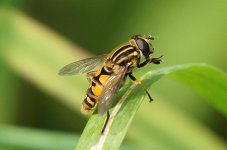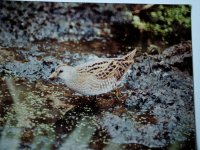-
Welcome to BirdForum, the internet's largest birding community with thousands of members from all over the world. The forums are dedicated to wild birds, birding, binoculars and equipment and all that goes with it.
Please register for an account to take part in the discussions in the forum, post your pictures in the gallery and more.
You are using an out of date browser. It may not display this or other websites correctly.
You should upgrade or use an alternative browser.
You should upgrade or use an alternative browser.
Upton Warren (24 Viewers)
- Thread starter andythomas
- Start date
More options
Who Replied?upstarts1979
Well-known member
Keith M has just let me know that the Moors water level is up 10 cm and plenty of water in the seasonaal pool. Terns are catching plenty of fish.
If anybody goes to the Flashes could you note the water level and let us know what it is.
If anybody goes to the Flashes could you note the water level and let us know what it is.
wheatearlp
Well-known member

Water level must have risen since I left Moors at c.9.00am as there appeared to be no appreciable rise by then (I arrived at 7.45). Nothing different to report compared to yesterday, although the surviving Oystercatcher juvenile appears to have a damaged leg and it looked then than impressed by the constant heavy rain. Lots of feeding activity in front of east hide from Reed Warblers and Reed Buntings, a brief Water Rail view across the only bit of open shoreline in front of the hide and a Snipe appeared on east island and headed off south-east at 8.10.
upstarts1979
Well-known member
Rob has sorted the sluice at the Flashes by removing the sluice board. The water had risen to a level 0.5 a 7cm increase. I will replace it tomorrow night, when hopefully it will have dropped by 5cm.
B Rob
Rob
Earlier Craig had a juv Ringed Plover.
B
Earlier Craig had a juv Ringed Plover.
Last edited:
Phil Andrews
It's only Rock and Roller but I like it

Saturday 19th July 14:00-17:45
MOORS POOL - water level 0.79
1 Common Sandpiper, 5 Avocet (family party of 2 adults + 2 juvs with a lone adult), 1 Lapwing, 4 adult Oystercatcher + 1 chick (looking notably unwell and not seen to be fed in the 1.5 hours I was in the East Hide), 1 fem + 10 juv Shoveler (now capable of flight), 1 Teal (North Moors), 82 Mallard, 25 Tufted Duck plus many young, 1 GC Grebe, 6 adult + 2 juv Little Grebe (1+0 Amy's, 1+1 Broadmeadow, 1+0 southwest marsh, 2+1 north end, 1+0 north end), 20 BH Gull, no larger gulls, 140 Coot, 4 Moorhen, 2 Mute Swan + 6 cygnets, 9 Canada Geese, 3 Grey Heron, Common Tern - 10 adults, 3 fledged juvs + 3 chicks (2 on new raft, 1 on North Island).
SAILING POOL
2 Greylag Geese over, 27 Canada Geese, 1 Tufted Duck, 1 Moorhen, 5 Coot, 47 Mallard, 1 adult GC Grebe + 3 juvs.
FLASHES - water level 0.48
Ringed Plover juv (nice one Craig :t , 9 Green Sand, 4 Common Sand, 7 Curlew, 7 LR Plover, 7 Lapwing, 18 adult / juv Avocet + 9 chicks still, 3 Oystercatcher + 1 chick (now on beach between second and third Flashes), 140 Mallard, 10 Teal, Shoveler fem (third Flash), eclipse Gadwall, 2 Tufted Duck (fresh brood of 5 on the third Flash), 1 Grey Heron, 13 Moorhen, 20 Coot, c20 BH Gull, 18 Stock Dove.
, 9 Green Sand, 4 Common Sand, 7 Curlew, 7 LR Plover, 7 Lapwing, 18 adult / juv Avocet + 9 chicks still, 3 Oystercatcher + 1 chick (now on beach between second and third Flashes), 140 Mallard, 10 Teal, Shoveler fem (third Flash), eclipse Gadwall, 2 Tufted Duck (fresh brood of 5 on the third Flash), 1 Grey Heron, 13 Moorhen, 20 Coot, c20 BH Gull, 18 Stock Dove.
Redstarts not seen but two birds heard "hooeting" along transmitter field hedgerow.
PS It was a female / juvenile Redstart that Jared had on Thursday
MOORS POOL - water level 0.79
1 Common Sandpiper, 5 Avocet (family party of 2 adults + 2 juvs with a lone adult), 1 Lapwing, 4 adult Oystercatcher + 1 chick (looking notably unwell and not seen to be fed in the 1.5 hours I was in the East Hide), 1 fem + 10 juv Shoveler (now capable of flight), 1 Teal (North Moors), 82 Mallard, 25 Tufted Duck plus many young, 1 GC Grebe, 6 adult + 2 juv Little Grebe (1+0 Amy's, 1+1 Broadmeadow, 1+0 southwest marsh, 2+1 north end, 1+0 north end), 20 BH Gull, no larger gulls, 140 Coot, 4 Moorhen, 2 Mute Swan + 6 cygnets, 9 Canada Geese, 3 Grey Heron, Common Tern - 10 adults, 3 fledged juvs + 3 chicks (2 on new raft, 1 on North Island).
SAILING POOL
2 Greylag Geese over, 27 Canada Geese, 1 Tufted Duck, 1 Moorhen, 5 Coot, 47 Mallard, 1 adult GC Grebe + 3 juvs.
FLASHES - water level 0.48
Ringed Plover juv (nice one Craig :t
Redstarts not seen but two birds heard "hooeting" along transmitter field hedgerow.
PS It was a female / juvenile Redstart that Jared had on Thursday
Last edited:
upstarts1979
Well-known member
Craig has just texted me his night time sightings.
A stunning fresh Juvenile Med Gull came in at 9.35pm with a huge party of 600 BHG from the east. 2 x 2nd winter common gulls, a 1000+ BHG had roosted by 9.50pm. Green Sand 10, curlew 21, common tern 2, shelduck 2 greylag 15.
:t: nice one Craig
A stunning fresh Juvenile Med Gull came in at 9.35pm with a huge party of 600 BHG from the east. 2 x 2nd winter common gulls, a 1000+ BHG had roosted by 9.50pm. Green Sand 10, curlew 21, common tern 2, shelduck 2 greylag 15.
:t: nice one Craig
Phil Andrews
It's only Rock and Roller but I like it

Craig has just texted me his night time sightings.
A stunning fresh Juvenile Med Gull came in at 9.35pm with a huge party of 600 BHG from the east. 2 x 2nd winter common gulls, a 1000+ BHG had roosted by 9.50pm. Green Sand 10, curlew 21, common tern 2, shelduck 2 greylag 15.
:t: nice one Craig
I was only commenting to Craig this afternoon on the lack of any Med Gull action so far this month which is usually a hot-spot. The Shelduck weren't present at either the Flashes or Moors this afternoon; I wonder where they got to during the day?
upstarts1979
Well-known member
I was only commenting to Craig this afternoon on the lack of any Med Gull action so far this month which is usually a hot-spot. The Shelduck weren't present at either the Flashes or Moors this afternoon; I wonder where they got to during the day?
the shelduck could be passage birds, our birds have probably moved off to moult in the Wadden sea or maybe Bridgewater Bay and these 2 are probably on their way too.:t:
shame about the Oyc's, I just hope the Flashes chick is now fed some large worms as opposed to the tiny morsels it is receiving of late
frisky pheasant
Active member
6 oycs just dropped in on moors
Phil Andrews
It's only Rock and Roller but I like it

Spotted Crake
Spotted Crake Porzana porzana
With birds reported today in Somerset, Gloucestershire and Dorset I thought it was worth an update of this species at Upton Warren.
Spotted Crake breeds in swamps and marshes in mainland Europe (and in very small numbers in Britain) and winters in the Mediterranean area and eastern Africa. It has a well-established migration in August and September, with birds from the Scandinavian and north European breeding populations regularly occurring in coastal locations, with smaller numbers inland. When occurring at sites where Water Rail breed (such as Upton Warren) there is the potential for confusion with juvenile Water Rail, especially as both may be sighted in early autumn. The reserve has six records, with efforts made in recent years to encourage the species (or at least sightings of it) by the cutting of suitable strategically located channels in the reed-beds at the Flashes and Moors Pool during late summer and early autumn to improve the chances of observing this elusive species.
(1) 1st>19th September 1981 - North Moors Pool
(2) 8th>13th October 1994 - Moors Pool
(3) 13th July 1999 (adult) - The Flashes
(4) 14th August 2001 - Moors Pool
(5) 15th August 2009 (juvenile) - Moors Pool
(6) 11th September 2012 (adult) - The Flashes
The first two records for the reserve showed well intermittently over a number of days, with the 1994 bird frequenting the sluice basin area of the Moors Pool to the south of the West Hide. The last four records have involved generally elusive one-day birds. The 1999 record was seen in the south west corner of the second Flash and showed for over an hour before disappearing into the juncus and long grass, not to be relocated. The 2001 bird appeared in the afternoon in front of the concrete hide at the Moors Pool following strimming work and remained on view for 30 minutes before making a brief re-appearance at 7:00 pm the same evening. The 2009 bird formed part of a "red-letter day" with a Montagu's Harrier at the Flashes earlier in the day; it was visible in cut reeds on the west side of the Moors Pool between 4:00pm and 7:20pm from the West Hide and then the Concrete Hide. The most recent (2012) bird was present on the south-west shore of the second Flash for a short period in the evening.
The elusive nature of this species could lead one to speculate on the real level of occurrence of this shy and retiring bird at Upton Warren, which remains Worcestershire’s leading site for sightings, with only a further nine records for the rest of the county.
John Ridley’s personal account of the reserve’s first Spotted Crake is kindly reproduced below:
“The car park corner of the North Moors pool was not overgrown with willows in 1981 and the area adjacent to the road, due to the low water levels that autumn, looked ideal for crakes and rails. I had been visiting the reserve on an almost daily basis during August and had been disappointed that I had seen nothing at all there. Just before dusk on 1st September 1981, Roger Broadbent and I were walking back to our cars when I suggested that we watched this muddy, reed fringed area for a few moments before dark. Almost immediately, a Water Rail appeared on the edge of the reeds, followed by another, obviously smaller bird with what appeared to be buffish undertail coverts. The second bird immediately disappeared into the reeds and momentarily I was left wondering what I had seen. A few seconds later both birds re-appeared and in the gathering gloom we could see that it was a Spotted Crake, a first for the reserve. Over the next few days the bird performed spectacularly well for the assembled birdwatchers and provided excellent photographic opportunities. The bird stayed in the same spot for three weeks and for many local birdwatchers was the first chance to catch up with this species in the West Midlands”.
Attached below are Carl Day's photo of the 2012 bird and Pete Walkden's of the 2009 bird
Spotted Crake Porzana porzana
With birds reported today in Somerset, Gloucestershire and Dorset I thought it was worth an update of this species at Upton Warren.
Spotted Crake breeds in swamps and marshes in mainland Europe (and in very small numbers in Britain) and winters in the Mediterranean area and eastern Africa. It has a well-established migration in August and September, with birds from the Scandinavian and north European breeding populations regularly occurring in coastal locations, with smaller numbers inland. When occurring at sites where Water Rail breed (such as Upton Warren) there is the potential for confusion with juvenile Water Rail, especially as both may be sighted in early autumn. The reserve has six records, with efforts made in recent years to encourage the species (or at least sightings of it) by the cutting of suitable strategically located channels in the reed-beds at the Flashes and Moors Pool during late summer and early autumn to improve the chances of observing this elusive species.
(1) 1st>19th September 1981 - North Moors Pool
(2) 8th>13th October 1994 - Moors Pool
(3) 13th July 1999 (adult) - The Flashes
(4) 14th August 2001 - Moors Pool
(5) 15th August 2009 (juvenile) - Moors Pool
(6) 11th September 2012 (adult) - The Flashes
The first two records for the reserve showed well intermittently over a number of days, with the 1994 bird frequenting the sluice basin area of the Moors Pool to the south of the West Hide. The last four records have involved generally elusive one-day birds. The 1999 record was seen in the south west corner of the second Flash and showed for over an hour before disappearing into the juncus and long grass, not to be relocated. The 2001 bird appeared in the afternoon in front of the concrete hide at the Moors Pool following strimming work and remained on view for 30 minutes before making a brief re-appearance at 7:00 pm the same evening. The 2009 bird formed part of a "red-letter day" with a Montagu's Harrier at the Flashes earlier in the day; it was visible in cut reeds on the west side of the Moors Pool between 4:00pm and 7:20pm from the West Hide and then the Concrete Hide. The most recent (2012) bird was present on the south-west shore of the second Flash for a short period in the evening.
The elusive nature of this species could lead one to speculate on the real level of occurrence of this shy and retiring bird at Upton Warren, which remains Worcestershire’s leading site for sightings, with only a further nine records for the rest of the county.
John Ridley’s personal account of the reserve’s first Spotted Crake is kindly reproduced below:
“The car park corner of the North Moors pool was not overgrown with willows in 1981 and the area adjacent to the road, due to the low water levels that autumn, looked ideal for crakes and rails. I had been visiting the reserve on an almost daily basis during August and had been disappointed that I had seen nothing at all there. Just before dusk on 1st September 1981, Roger Broadbent and I were walking back to our cars when I suggested that we watched this muddy, reed fringed area for a few moments before dark. Almost immediately, a Water Rail appeared on the edge of the reeds, followed by another, obviously smaller bird with what appeared to be buffish undertail coverts. The second bird immediately disappeared into the reeds and momentarily I was left wondering what I had seen. A few seconds later both birds re-appeared and in the gathering gloom we could see that it was a Spotted Crake, a first for the reserve. Over the next few days the bird performed spectacularly well for the assembled birdwatchers and provided excellent photographic opportunities. The bird stayed in the same spot for three weeks and for many local birdwatchers was the first chance to catch up with this species in the West Midlands”.
Attached below are Carl Day's photo of the 2012 bird and Pete Walkden's of the 2009 bird
Attachments
Last edited:
upstarts1979
Well-known member
Vern's update from Moors
Water level dropping after Rob had removed board from Moors sluice, will keep open to get back to normal level. The last few weeks the level has been too low, so we can now rectify that.
The Oyc chick is looking a bit lame, but parents have brought in large worms.
The 10 shoveler chicks are now flying, 37 days old, also 3 females.
The seasonal pool is now pretty full , so worth checking for passage waders.
6 Oycs just dropped into Amy's Marsh.
Water level dropping after Rob had removed board from Moors sluice, will keep open to get back to normal level. The last few weeks the level has been too low, so we can now rectify that.
The Oyc chick is looking a bit lame, but parents have brought in large worms.
The 10 shoveler chicks are now flying, 37 days old, also 3 females.
The seasonal pool is now pretty full , so worth checking for passage waders.
6 Oycs just dropped into Amy's Marsh.
Phil Andrews
It's only Rock and Roller but I like it

Turning away from birds for a second, the last week has seen an unprecedented invasion of Scarce (Yellow-legged) Tortoiseshell butterflies from the East. Most records so far have been in Norfolk with other sightings elsewhere on the east coast (Kent Lincs, Suffolk). However yesterday one was recorded in Rutland so they are making their way west; well worth keeping an eye out for.
http://en.wikipedia.org/wiki/Yellow-legged_Tortoiseshell
http://en.wikipedia.org/wiki/Yellow-legged_Tortoiseshell
upstarts1979
Well-known member
The Moors: The sluice was opened by Rob last night and 3 cm have dropped off already, we will leave it open until Tuesday when it water level should be around 0.7. The pool island is now split in half again, but will be joined by Tuesday.
special attention was made on the little grebes.
It is worth Scoping all around the pool, as the birds skulk close to the edge in the peripheral vegetation. Today this method revealed a new brood of 3 just in front of the fallen tree in the NE with both parents. On the 18th an adult was chasing off an adult and 2 large juvs. This was obviously a prelude to bringing out the chicks.
I didn't see the 2 juvs or the adult, but assume they are close by. A juv was in the north and an adult close by, 2 adults were along the west side and a juv and adult in the SW marsh. An adult and juv were on the Broadmeadow pool.
Thus
adults 7 min. Juvs 3, chicks 3. Also at the Flashes 2 fledged juvs were seen from the cuckoo hide in the SW corner of 1st Flash, these would almost certainly be from the Moors and were probably the 1st brood from the the parents with the new chicks.
The Oyc chick was asleep most of the time and not fed once by his parents, who were indulged in vocal jousting bouts with the 6 passage birds.
The common terns chicks on the new raft were still ok , but I couldn't find the other unfledged chick. The 4 juveniles were all actively fishing.
I didn't count the tufted broods but there were possibly more than the 13 counted on 18th July.
Species count Moors
GCG 3, little grebe 10 + 3 chicks, shoveler fem + 10 flying young, tufted 35 ads + 75 + chicks, greylags 15, Oystercatcher 8 ads + 1 juv, lapwing 25, common tern 10 ads + 6 juv/chicks.
rook 20 flying north presumably moving between recently harvested crop fields. Jay, kingfisher 2 chasing each other in Amy's marsh, swift c10
collared dove 4, reed warblers many feeding around east side, whitethroat family to right of east hide,
special attention was made on the little grebes.
It is worth Scoping all around the pool, as the birds skulk close to the edge in the peripheral vegetation. Today this method revealed a new brood of 3 just in front of the fallen tree in the NE with both parents. On the 18th an adult was chasing off an adult and 2 large juvs. This was obviously a prelude to bringing out the chicks.
I didn't see the 2 juvs or the adult, but assume they are close by. A juv was in the north and an adult close by, 2 adults were along the west side and a juv and adult in the SW marsh. An adult and juv were on the Broadmeadow pool.
Thus
adults 7 min. Juvs 3, chicks 3. Also at the Flashes 2 fledged juvs were seen from the cuckoo hide in the SW corner of 1st Flash, these would almost certainly be from the Moors and were probably the 1st brood from the the parents with the new chicks.
The Oyc chick was asleep most of the time and not fed once by his parents, who were indulged in vocal jousting bouts with the 6 passage birds.
The common terns chicks on the new raft were still ok , but I couldn't find the other unfledged chick. The 4 juveniles were all actively fishing.
I didn't count the tufted broods but there were possibly more than the 13 counted on 18th July.
Species count Moors
GCG 3, little grebe 10 + 3 chicks, shoveler fem + 10 flying young, tufted 35 ads + 75 + chicks, greylags 15, Oystercatcher 8 ads + 1 juv, lapwing 25, common tern 10 ads + 6 juv/chicks.
rook 20 flying north presumably moving between recently harvested crop fields. Jay, kingfisher 2 chasing each other in Amy's marsh, swift c10
collared dove 4, reed warblers many feeding around east side, whitethroat family to right of east hide,
Phil Andrews
It's only Rock and Roller but I like it

The Oyc chick was asleep most of the time and not fed once by his parents, who were indulged in vocal jousting bouts with the 6 passage birds.
The common terns chicks on the new raft were still ok , but I couldn't find the other unfledged chick. The 4 juveniles were all actively fishing.
I didn't count the tufted broods but there were possibly more than the 13 counted on 18th July.
I would be surprised if the Oyk will still be present next time you visit on Tuesday. Yesterday the third term chick was on the southern end of the North Island and was looking fine with an adult in regular attendance.
Last edited:
upstarts1979
Well-known member
FLASHES
The water level had dropped 4cm, since yesterday to 0.46. I have replaced the board and allowed a trickle to flow and by Tuesday we should be back to pre flooding level. The higher water has acted almost like a tidal ingress and freshened up the previously dry areas in the 'Archipelago' and 'saucer'. By opening the sluice, in effect the tide is going out. There was a good gathering of 200 Lapwing (per Ian and Claire J) on the dead zone between 2nd and 3rd Flash. The pair of Oystercatchers and its chick were in the same area and regularly bringing in food.
The saucer and its immediate surrounds were holding most of the migrant waders and semi tolerated by the parent avocets, that did not allow LBBG anywhere near the lagoons. Most of the large gulls have learned to skirt around the reserve. But occasionally a juvenile LBBG will get too close and all 6 breeding adults will attack en masse, this also benefits the breeding duck chicks. Unfortunately I could stay for the roost, but birds were dropping in all the time. Hopefully Margaret, Phil and Tony stayed to check out the roost.
Species count FLASHES
Little grebe 2 juvs, greylag 15 ( from Moors), Teal 6, shoveler fem, mallard 120 ( + 3 broods), Tufted fem and 5 chicks 3rd Flash. Shelduck 3 ( pr + juv) arrived at 8.40. Avocet 16 ads/juvs + 9 chicks, LRP 5 ( 3 ads + 2 juvs - 1 very freshly fledged), Ringed plover juv, green sand 10, common sand 5 all adults, lapwing 200, curlew 22, Oystercatcher 8 ads ( 6 from Moors) + 1 chick, common tern, BHG 250 + 5 broods of small chicks, green woodpecker, stock dove 43, swift 5, song thrush singing,
Sailing pool
GCG 2 ads + 3 ch
The water level had dropped 4cm, since yesterday to 0.46. I have replaced the board and allowed a trickle to flow and by Tuesday we should be back to pre flooding level. The higher water has acted almost like a tidal ingress and freshened up the previously dry areas in the 'Archipelago' and 'saucer'. By opening the sluice, in effect the tide is going out. There was a good gathering of 200 Lapwing (per Ian and Claire J) on the dead zone between 2nd and 3rd Flash. The pair of Oystercatchers and its chick were in the same area and regularly bringing in food.
The saucer and its immediate surrounds were holding most of the migrant waders and semi tolerated by the parent avocets, that did not allow LBBG anywhere near the lagoons. Most of the large gulls have learned to skirt around the reserve. But occasionally a juvenile LBBG will get too close and all 6 breeding adults will attack en masse, this also benefits the breeding duck chicks. Unfortunately I could stay for the roost, but birds were dropping in all the time. Hopefully Margaret, Phil and Tony stayed to check out the roost.
Species count FLASHES
Little grebe 2 juvs, greylag 15 ( from Moors), Teal 6, shoveler fem, mallard 120 ( + 3 broods), Tufted fem and 5 chicks 3rd Flash. Shelduck 3 ( pr + juv) arrived at 8.40. Avocet 16 ads/juvs + 9 chicks, LRP 5 ( 3 ads + 2 juvs - 1 very freshly fledged), Ringed plover juv, green sand 10, common sand 5 all adults, lapwing 200, curlew 22, Oystercatcher 8 ads ( 6 from Moors) + 1 chick, common tern, BHG 250 + 5 broods of small chicks, green woodpecker, stock dove 43, swift 5, song thrush singing,
Sailing pool
GCG 2 ads + 3 ch
upstarts1979
Well-known member
I would be surprised if the Oyk will still be present next time you visit on Tuesday. Yesterday the third term chick was on the southern end of the North Island and ws looking fine with an adult in regular attendance.
maybe its on the north island , will check Tuesday when the water is lower. Agree Oyc looks doomed:-C.
Birder Gladys
Well-known member
hi all
nice to see fellow birders today and to catch up with all the news,also good to see such a large variety of birds plus such a successful breeding season. Only can add to todays list, Sparrow hawk hunting around sailing pool buildings on the way to the flashes and Kingfisher flying across s/pool when we returned, did think we had a early siskin near cuckoo hide but on doing a lot of homework it looks like it was a juv greenfinch.
nice to see fellow birders today and to catch up with all the news,also good to see such a large variety of birds plus such a successful breeding season. Only can add to todays list, Sparrow hawk hunting around sailing pool buildings on the way to the flashes and Kingfisher flying across s/pool when we returned, did think we had a early siskin near cuckoo hide but on doing a lot of homework it looks like it was a juv greenfinch.
upstarts1979
Well-known member
My photo of the 1981 bird...crap quality of a photo of my original photo (should have scanned it)Spotted Crake Porzana porzana
With birds reported today in Somerset, Gloucestershire and Dorset I thought it was worth an update of this species at Upton Warren.
The reserve has six records, with efforts made in recent years to encourage the species (or at least sightings of it) by the cutting of suitable strategically located channels in the reed-beds at the Flashes and Moors Pool during late summer and early autumn to improve the chances of observing this elusive species.
(1) 1st>19th September 1981 - North Moors Pool
(2) 8th>13th October 1994 - Moors Pool
(3) 13th July 1999 (adult) - The Flashes
(4) 14th August 2001 - Moors Pool
(5) 15th August 2009 (juvenile) - Moors Pool
(6) 11th September 2012 (adult) - The Flashes
John Ridley’s personal account of the reserve’s first Spotted Crake is kindly reproduced below:
“The car park corner of the North Moors pool was not overgrown with willows in 1981 and the area adjacent to the road, due to the low water levels that autumn, looked ideal for crakes and rails. I had been visiting the reserve on an almost daily basis during August and had been disappointed that I had seen nothing at all there. Just before dusk on 1st September 1981, Roger Broadbent and I were walking back to our cars when I suggested that we watched this muddy, reed fringed area for a few moments before dark. Almost immediately, a Water Rail appeared on the edge of the reeds, followed by another, obviously smaller bird with what appeared to be buffish undertail coverts. The second bird immediately disappeared into the reeds and momentarily I was left wondering what I had seen. A few seconds later both birds re-appeared and in the gathering gloom we could see that it was a Spotted Crake, a first for the reserve. Over the next few days the bird performed spectacularly well for the assembled birdwatchers and provided excellent photographic opportunities. The bird stayed in the same spot for three weeks and for many local birdwatchers was the first chance to catch up with this species in the West Midlands”.
Attachments
Similar threads
- Replies
- 1
- Views
- 1K




